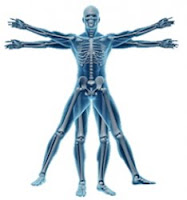The central nervous system is bathed in fluid. This fluid provides a buffer against shock, as well as providing a good medium for the transmission of chemical signals. (Electrical signals are handled by the neurons.) The central nervous system is extremely sensitive to dehydration, which is why headaches are so common: most people are somewhat dehydrated. We consider ourselves too busy to drink water and whizz it out again.
Water is also the main ingredient of blood and lymph. These two essential fluids bring nutrition to the cells, transport chemical signals such as hormones and regulatory signals, and carry away cellular garbage. When there’s not enough of them, that doesn’t happen very well. More garbage piles up in the tissues, aging happens faster, disease trends faster, our muscles get stiffer, it’s harder to recuperate from injuries and illnesses, our sex lives suffer, and we just don’t feel as good.
With that in mind, not having the time to drink in water, process it through, and whizz it out again doesn’t really make sense, but a lot of us are really attached to that idea.
Reality checks
One of the really ducky things about diseases like CRPS, especially when there is strong autonomic involvement, is that normal quantities of fluids (and vitamins, proteins, and other nutrients) are often inadequate to our unusual metabolic needs. It may be possible for a basically healthy person to meet all their needs with three good meals and three or four liters of water per day, but for systems so consistently under siege as those with CRPS, it may be impossible to meet metabolic needs within these (otherwise very reasonable) parameters.
I have several friends with terrible vertigo, due to autonomic dysfunction in CRPS. This isn’t the, “I held my breath too long,” kind of dizziness. This is the kind of dizziness where you can’t keep your feet under you, you feel like you’re going to throw up, and it JUST WON’T QUIT.
The mechanism behind this has only been researched recently. It’s not very well understood. I’m hoping for an informative comment from an expert on this…
What’s happening (partly) is that the vessels, which are directed by the autonomic nervous system, are flopping open too much. This means that the normal amount of fluid in the blood, lymph, and cerebrospinal fluid has to fill a space that’s considerably larger than normal. What you get is a type of hypovolemic shock, where the brain and major organs simply can’t get enough nutrition, oxygen, and garbage collection.
This normally happens on a short-term basis, after some assault on the system; normally, it’s either corrected quickly, or the person dies.
There are very few instances where this happens continuously over time, but with CRPS, some people have to live with it. It can make doing anything impossible, and if you try to imagine, just for 5 minutes, what it’s like to be that desperately dizzy and try to do anything — even get a fork to your mouth without bloodshed — you’ll see what I mean.
Sometimes, these symptoms can be somewhat reduced. There are pharmaceutical and mechanical approaches, each with its drawbacks and benefits. Since doctors (and many patients) tend to think in terms of pharmaceuticals first, let’s start there.
Pharmaceutical management
Whenever you think in terms of disease and pharmaceuticals, it’s important to keep in mind that:
- Every system is unique.
- Every system with CRPS is even stranger.
- Unless you’re a doctor getting a visit from a pharmaceutical rep, there is no such thing as a free lunch. Everything you take in affects your whole system. With our systems under siege, it behooves us to be mindful of our chemistry.
NB: This is not intended to diagnose, treat, or cure any disease. Consult your physician with any questions, and if your doctor can’t give you a credible answer, get a referral to someone who might be able to.
Vasopressors, which can help restrict blood vessel size, have mixed results. They depend on the regulatory system being able to work somewhat, which is problematic in CRPS. Moreover, they have their own side effects, and given what a cocktail of medications most people with CRPS are on anyway, this can be quite noticeable. It has to be handled on a case-by-case basis.
Anti-dizziness pills, such as Atarax, affect the central nervous system and tend to make people sleepy and goofy. They are related to antihistamines and acid-suppressing medications (H2 inhibitors), and for those with hotwired immune systems and the nutrient assimilation problems common in chronic CRPS, they’re not without side effects. Moreover, because they address only the generic mechanism for dizziness, but not the particular mechanism for CRPS/ANS vertigo, they don’t necessarily help in these cases. Also, case-by-case basis.
Some SSRIs, typically used as antidepressants but extremely effective for nerve pain, can also provide support for the ANS. There is additional benefit to the use of SSRIs, because of their assistance with the nerve pain component of CRPS; when they can also improve the autonomic nervous system, it’s a big deal. Naturally, SSRIs being the idiosyncratic category that they are, it can take a few tries to find the one that works best in each person’s system. As I learned the hard way, getting the dose right can be a long and interesting task, given the idiosyncratic nature of our systems.
Mechanical management
Mechanically, it’s possible to increase blood volume by taking in lots of fluids, even if you already drink “enough.” “Enough” is a relative term, and what’s “enough” for a person with a normal autonomic nervous system may be “completely inadequate” for somebody with vertigo due to CRPS.
Blood pressure is a complex system, involving more than just fluid, vessels and the brain. Maintaining electrolytes helps contribute to a healthier fluid balance, and towards that end, sometimes doctors suggest increasing your salt intake. That only raises your blood pressure when you already have a predisposition to high blood pressure, so it may not be obviously useful; however, adequate sodium is important in maintaining renal function and supporting potassium levels.
Potassium is another key electrolyte, along with magnesium (found in Epsom salt), calcium, and bicarbonate. It doesn’t take much; four or five of the smallest grains of Epsom salt, stirred into a glass of water, can make a noticeable difference when you are magnesium depleted. Also, it usually makes the water taste better.
It’s easy to tell when you’ve taken too much, partly because it doesn’t taste good, but especially when it gives you the runs. Less is generally better than more!
Bicarbonate is better managed by eating plenty of vegetables, rather than trying to supplement and get the dose just right. Having an overly alkaline system doesn’t feel very good, either.
Calcium and magnesium are present in food, especially if you’re eating plenty of nuts and leafy greens. If you have CRPS, you really want to eat plenty of nuts and leafy greens! They provide so much in the way of A and B vitamins, antioxidants, minerals (which support cellular processes and regulation), healthy fats (which help your body absorb your nutrients and protect your nerves), fiber, digestible protein (which helps your body absorb the calcium), and so much else of what your body really needs.
Activity, even horizontal activity, even just stretching out gently in bed, provides the body with much needed prompting about how to keep things moving. It keeps your muscles loose, so that your body is more comfortable to live in; it also activates sensors in your joints which communicate with your body’s regulatory mechanisms, and this helps with maintaining blood pressure (one can only hope it helps enough.)
Any movement is better than no movement.
Changes in position should happen slowly, which is terribly frustrating, but it’s going to take as long as it takes. If your body doesn’t get to move, it forgets how to handle itself in movement. This becomes a negative feedback loop.
So, keep moving, even if you’re not moving in any way that the doctor would recognize. Frankly, most doctors are somewhat limited in their ideas of what constitutes exercise. Most of them have no trouble walking from the car to the office, let alone from the bedroom to the kitchen.
Don’t let perfection assassinate your drive towards improvement. Do what you can, and don’t sweat the rest.
- If you can’t run around the park, walk around the block;
- If you can’t walk around the block, practice ballet or t’ai chi with one hand on the back of the sofa;
- If you can’t do that, fire up YouTube and do chair qi gong or chair yoga;
- If you can’t do that, stretch out gently in bed, and do range of motion exercises. (This is a wonderfully pretentious term for moving each limb all the way up, then all the way down; all the way in, then all the way out.)
There is always something you can do to keep your joints active.
Moving your joints sends a message to your regulatory centers that they need to pay a little more attention to your blood pressure. That’s why it’s important to stay active. Our regulatory systems are screwed up enough; we need to keep them gently tuned, and be persistent about it, even when it seems absurd to do so. The habit of activity will serve you well for the rest of your life.
I’m aware that there are some herbs that have tonic effects on blood pressure and possibly the ANS. I would love to learn more about that.
Assume there is a future, and that what you do, even little things, can change how it goes.
That’s a good general policy, anyway. Especially with CRPS.
While I’ve known all this for many years, applying it to CRPS has been an education. When I’m able to focus a little longer, I’ll put together some references. Meanwhile, any of you who have references, either to support or contradict any of this, would be very welcome to post them in the comments.
I look forward to better science and better medicine for chronic vertigo in CRPS. It’s so thoroughly disabling, yet so thoroughly underrated.









